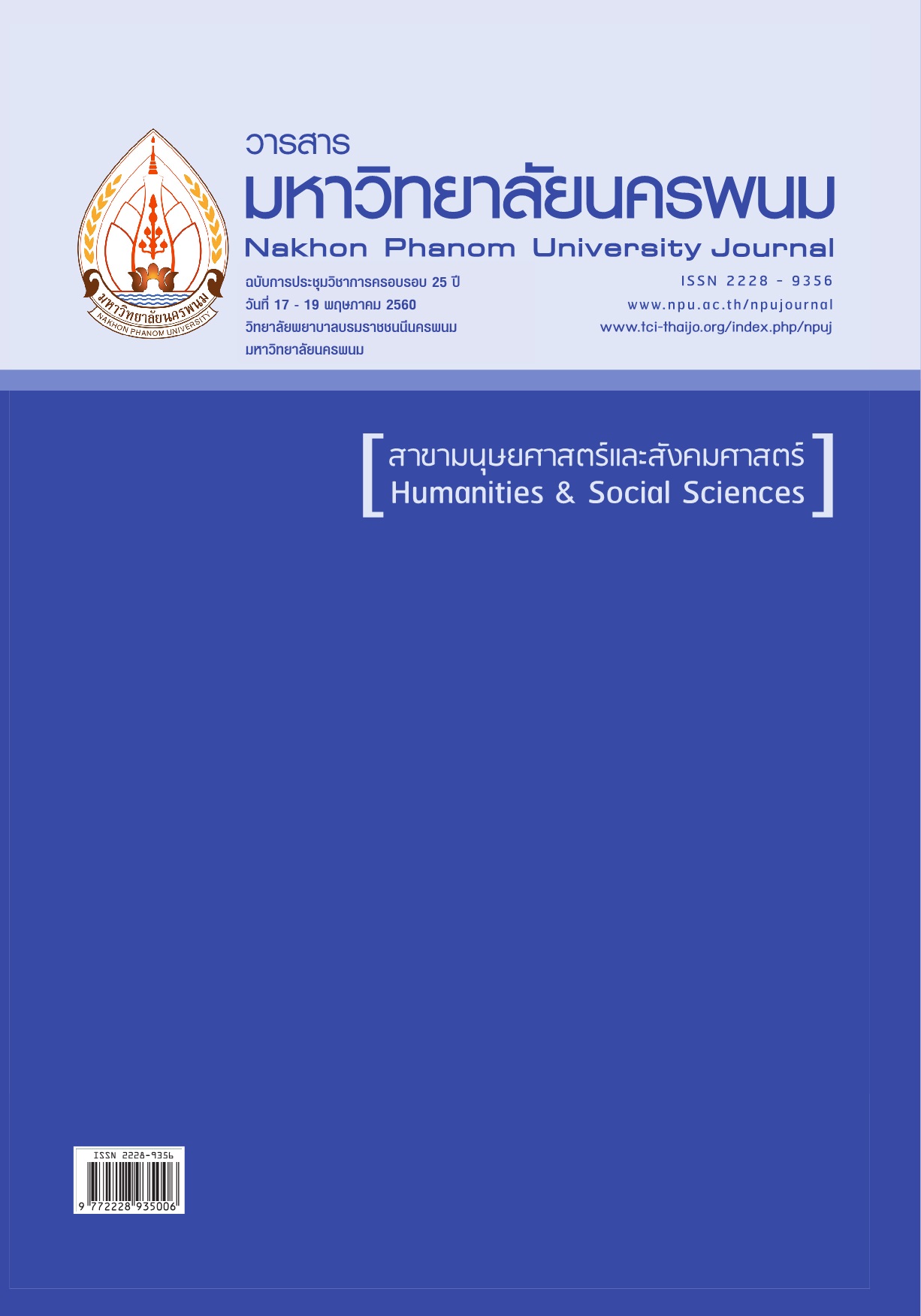พฤติกรรมการเตรียมอาหารปลอดภัยของสตรีตั้งครรภ์
Main Article Content
Abstract
การวิจัยนี้มีวัตถุประสงค์เพื่อสำรวจพฤติกรรมการเตรียมอาหารปลอดภัยของสตรีตั้งครรภ์ กลุ่มตัวอย่างเป็นสตรีตั้งครรภ์ในจังหวัดเชียงใหม่ จำนวน 200 ราย ซึ่งใช้วิธีการสุ่มตามสะดวก การเก็บรวบรวมข้อมูลใช้แบบสอบถามข้อมูลส่วนบุคคลและแบบวัดพฤติกรรมเกี่ยวกับอาหารปลอดภัยในสตรีตั้งครรภ์ (ค่าความสอดคล้องภายใน = 0.83 ค่าความเชื่อมั่นจากการทดสอบซ้ำ = 0.70) วิเคราะห์ข้อมูลด้วยสถิติเชิงพรรณนา
ผลการวิจัยพบว่า คะแนนเฉลี่ยพฤติกรรมฯ เท่ากับ 71.64 คะแนน/100 คะแนน (SD=8.69) จากการแบ่งระดับคะแนนพฤติกรรมฯ เป็น 5 ระดับคือ ต่ำมาก ต่ำ ปานกลาง สูง และสูงมาก คะแนนพฤติกรรมฯ จัดอยู่ในระดับสูง ด้านที่ได้คะแนนมากที่สุดคือ การปรุงสุก (สูงมาก) ตามมาด้วยด้านความสะอาด (สูง) การใช้วัตถุดิบปลอดการปนเปื้อน (สูง) การแยกอาหารดิบและสุก (ปานกลาง) และการรักษาอาหารในอุณหภูมิที่พอเหมาะ (ปานกลาง) ข้อที่มีคะแนนในระดับต่ำคือ ตรวจวัดอุณหภูมิตู้เย็น ข้อที่มีคะแนนระดับปานกลางมี 8 ข้อ คือ ล้างเปลือกไข่ อุ่นอาหารทุกๆ 2 ชั่วโมง กินผักดิบ ใช้ผ้าเช็ดอุปกรณ์ประกอบอาหารหลังจากล้าง ใช้เขียงและมีดปนกันระหว่างอาหารดิบและสุก วางอาหารไว้นอกตู้เย็นนานเกิน 2 ชั่วโมง เลือกผักที่ปลูกด้วยวิธีเกษตรอินทรีย์ และแยกภาชนะอาหารดิบและสุก
เนื่องจากคะแนนพฤติกรรมฯ ยังไม่ถึงระดับสูงมาก จึงควรมีการให้สุขศึกษาเรื่องการเตรียมอาหารปลอดภัยแก่สตรีตั้งครรภ์ โดยให้ความสำคัญกับด้านการรักษาอาหารในอุณหภูมิที่พอเหมาะเนื่องจากมีคะแนนต่ำที่สุดและอากาศร้อนในประเทศไทยทำให้อาหารบูดเสียได้ง่าย รวมทั้งแก้ไขความเข้าใจผิดเรื่องการรับประทานผักดิบ เนื่องจากกลุ่มตัวอย่างส่วนใหญ่พักอยู่ในเขตตัวเมือง จึงควรมีการศึกษาในเขตชนบท
Article Details
References
กรมอนามัย กระทรวงสาธารณสุข. (2554). กรมอนามัยเตือนอันตรายตะกั่วจากหม้อก๋วยเตี๋ยวด้อยคุณภาพ ชี้ พิษสะสมมากเสี่ยงอัมพาต. http://www.anamai.moph.go.th/ewt_news.php?nid=2818
พรพิมล กองทิพย์. (2559). การตกค้างของสารกำจัดศัตรูพืชในแม่และทารก. http://www.thaipan.org/sites/default/files/conference2559/pesticide_conference_2559_1.8.pdf
Al-Saleh, I., Shinwari, N., Mashhour, A., Mohamed, G. D., & Rabah, A. (2011). Heavy metals (lead, cadmium and mercury) in maternal, cord blood and placenta of healthy women. International Journal of Hygiene and Environmental Health, 214(2), 79-101.
Atherarn, P. N., Kendall, P. A., Val-Hillers, V., Schroeder, M., Bergmann, V., Chen, G., …Medeiros, L. C. (2004). Awareness and acceptance of current food safety recommendations during pregnancy. Maternal and Child Health Journal, 8(3), 149-162.
Barrett, E. S., Sathynarayana, S., Janssen, S., Redmon, J. B., Nguyen, R. H. N., Kobrosly, R., …Swan, S. H. (2014). Environmental health attitudes and behaviors: finding from a large pregnancy cohort study. European Journal of Obstetrics and Gynecology and Reproductive Biology, 176, 119-125. doi:10.1016/j.ejogrb.2014.02.029
Bermudez-Millan, A., Perez-Escamilla, R., Damio, G., Gonzalez, A., & Segura-Perez, S. (2004). Food safety knowledge, attitudes, and behaviours among Puerto Rican caretakers living in Hartford, Connecticut. Journal of Food Protection, 67(3), 512-516.
Borzsonyi, M., Bereczky, A., Rudnai, P., Csanady, M., & Horvath, A. (1992). Epidemiological studies on human subjects exposed to arsenic in drinking water in southeast Hungary. Archives of Toxicology, 66(1), 77-78.
CDC- Centers for Disease Control and Prevention, USA. (2013). Parasites – Toxoplasmosis. https://www.cdc.gov/parasites/toxoplasmosis/
Concha, G., Vogler, G., Lezeano, D., Nermell, B., & Vahter, M. (1998). Exposure to inorganic arsenic metabolites during early human development. Oxford Journals Toxicological Science, 44, 185-190. doi: 10.1093/toxsci/44.2.185
Cuningham, F. G., Leveno, K. J., Bloom, S. L., Spong, C. Y., Dashe, J. S., Hoffman, B. L., …Sheffield, J. S. (2014). Williams obstetrics (24th ed.). New York: McGraw-Hill C.
Feng, Y., Bruhn, C., & Marx, D. (2016). Evaluation of different food safety education interventions. British Food Journal, 118(4), 762-776. doi.org/10.1108/BFJ-10-2015-0372
Golub, M. S., Macintosh, M. S., & Baumrind, N. (1998). Developmental and reproductive toxicity of inorganic arsenic: animal studies and human concerns. Journal of Toxicology and Environmental Health, part B: Critical Reviews, 1(3), 199-237. doi:10.1080/10937409809524552
Janakiraman, V. (2008). Listeriosis in pregnancy: Diagnosis, treatment, and prevention. Rev Obstet Gynecol, Fall; 1(4), 179–185.
Jevsnik, M., Hoyer, S., & Raspos, P. (2008). Food safety knowledge and practices among pregnant and non-pregnant women in Slovenia. Journal of Food Control, 19, 526-534.
Kaewmai, K. (2008). Factors affecting food sanitation behaviors of food handlers in home at a subdistrict in Nan Province. Master thesis. Chiang Mai: Chiang Mai University.
Koseeyarat, N. (2010). The study of organic vegetable consumption demand of health shop consumer, Siriraj Bangkok Noi, Bangkok. Master thesis. Bangkok: Silpakorn University.
Lumpo, W. (2016). Food safety knowledge and behavior among pregnant women. Master thesis. Chiang Mai: Chiang Mai University.
Lyketsos, C. G. (2003). Should pregnant women avoid eating fish? Lessons from the Seychelles. The Lancet Global Health Journal, 361(9370), 1667-1168. doi: 10.1016/S0140-6736(03)13379-X
Menasveta, P., & Piyatiratitivorakul, S. (2008). Monitoring of mercury concentration in fish in the vicinity of natural gas production platform in the gulf of Thailand. http://www.conference.ifas.ufl.edu/emecs9/Presentations/Tuesday/Salon%203-4/am/Session%206/0835%20P%20Mebasveta.pdf
Myers, G. J., Devidson, P. W., Cox, C., Shamlaye, C. F., Palumbo, D., Cernichiari, E., …Clarkson, T. W. (2003). Prenatal methyl mercury exposure from ocean fish consumption in the Seychelles child development study. The Lancet Global Health Journal, 361(9370), 1686-1692. doi:10.1016/S0140-6736(03)13371-5
Nitaya, V., & Nuntavarn, V. (2011). Petrochemical industrial estate and its effects on pregnancy outcomes on the surrounding residents of Rayong province, Thailand. Journal of Clinical Epidemiology, 22(1), S167. doi:10.1097/01.ede.0000392187.26910.55
Okojie, O. H., Wagbatsoma, V. A., & lghoroge, A. D. (2005). An assessment of food hygiene among food handlers in a Nigerian university campus. Nigerian Postgraduate Medical Journal, 12(2), 93-96.
Paihok, T. (2010). Comparison of knowledge, attitude, and practice of food sellors using a learning program for food hygiene practice in Suwunburi. Master thesis. Maha Sarakham: Maha Sarakham University.
Paliyasit, K. (2012). Perception of mediawise information about food safety project of consumers in Mueang Chiang Mai District. Mater thesis. Chiang Mai: Chiang Mai University.
Sopontammapan, A. (2009). Harm from arsenic-contaminated water. http://www.etm.sc.mahidol.ac.th/a2.shtml
Taylor, M., Kelly, M., Noel, M., Brisdon, S., Berkowitz, J.,
Gustafson, L., …Galanis, E. (2012). Pregnant women’s knowledge, practices, and needs related to food safety and listeriosis a study in British Columbia. Journal of Canadian Family Physician, 58, 1106-1112.
ThaiHealth. (2014). Lead in Clity creek: A case study of healing community environment and health.
http://www.hiso.or.th/hiso/picture/ reportHealth/ThaiHealth2014/thai2014_20.pdf
Tofail, F., Vahter, M., Hamadani, J. D., Nermell, B., Huda, S. N., Yunus, M., ... & Grantham-McGregor, S. M. (2009). Effect of arsenic exposure during pregnancy on infant development at 7 months in rural Matlab, Bangladesh. Environmental Health Perspectives, 117(2), 288-293. doi: 10.1289/ehp.11670
Vorvick, L. J. (2014). Food safety. U.S. Department of Health and Human Services. https://ummedu/health/medical/ency/articles/food-safety
WHO. (1989). Report of safe food handling: a training guide for managers of food service establishments. Geneva: WHO. http://apps.who.int/iris/bitstream/10665/36870/1/9241542454_eng.pdf
WHO. (2001). Environmental health criteria 224: Arsenic and Arsenic Compounds (2nd ed.). Geneva: WHO.
WHO. (2006). Five keys to safer food manual. http://apps.who.int/iris/bitstream/10665/43546/1/9789241594639_eng.pdf
WHO. (2015). 10 Facts on food safety. http://www.who.int/ features/factfiles/food_safaty/en/
WHO-SEAR. (2015). Food safety: overview. http://www.searo.who.int/entity/foodsafety/ topics/overview/en/
Translated Thai References
Department of Health, Ministry of Public Health. (2011). Department of Health’s warning: Lead from noodles plots may cause palalysis. http://www.anamai.moph.go.th/ewt_news.php?nid=2818
Kongtip, P. (2016). Remaining of pesticides in mothers and child. http://www.thaipan.org/sites/default/files/conference2559/pesticide_conference_2559_1.8.pdf


